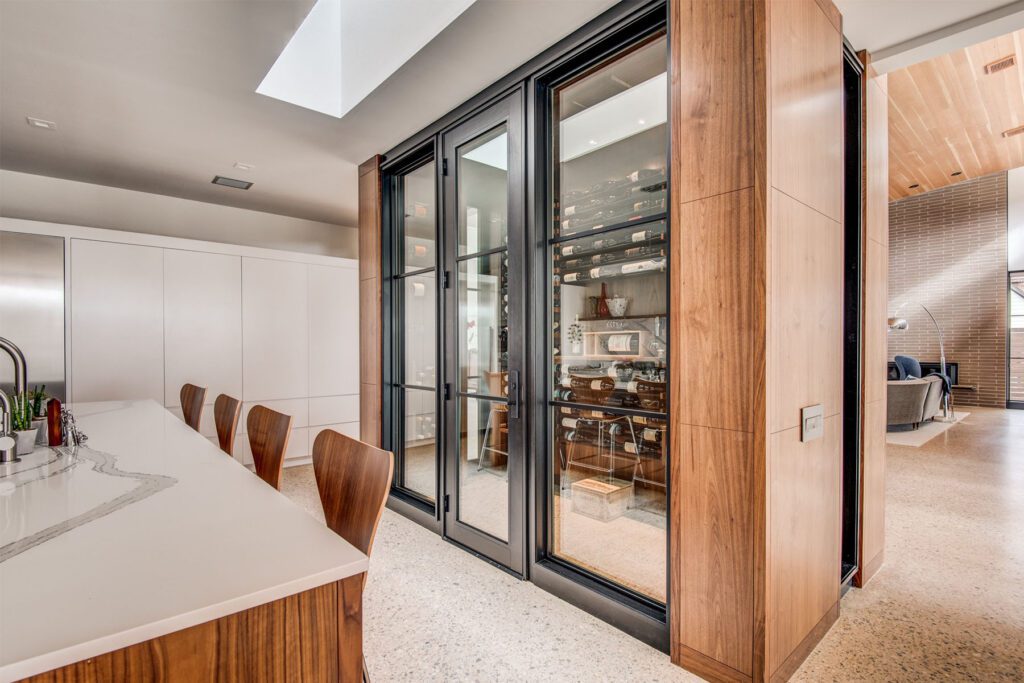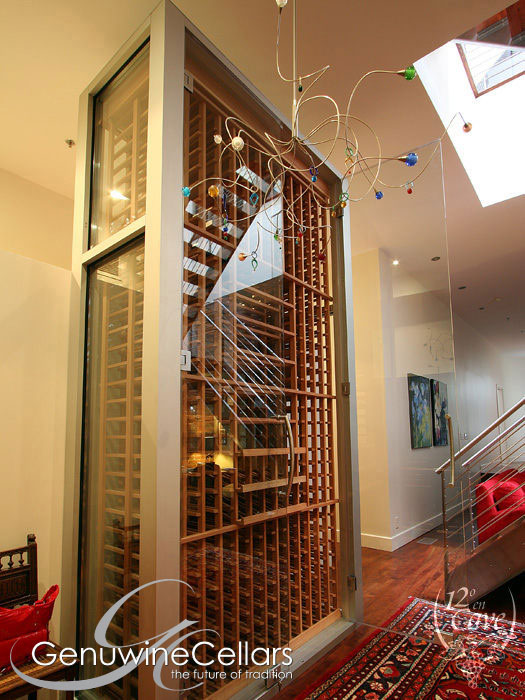Wine displays made entirely of glass lend an air of sophistication and elegance to any home or commercial space. Glass enclosures can store and age modest collections or they can display hundreds of vintages and maintain two separate temperatures for storing and serving. All-glass wine enclosures can delineate open concept spaces or be large enough to entertain a handful of guests. They add a bold statement to any space, regardless of size and scope.
However, as exciting as it is to design and build a contemporary wine enclosure, a display must be able to maintain pristine climate conditions. Awareness of several considerations and technical requirements will ensure a better outcome when glass is the predominant design element.

Why Climate Control Matters
Most wine lovers know that they should maintain their collections in a relatively cool environment. Some may be tempted to use a comfort cooling AC unit to keep temperatures low. However, mini-splits were designed to keep humans cool and comfortable around 72℉, not wine collections. Wine is best preserved in 50 to 70% relative humidity and 55 to 58℉.
Temperature fluctuations compromise and prematurely age wine. As the temperature in a bottle goes up, the wine expands and causes pressure in the bottle. A wine’s aroma ends up slowly leaking out through the cork, jeopardizing its quality. When the temperature drops, the air outside a bottle rushes in and compromises the flavor and aroma.
Humidity is also a critical component in wine preservation. Humidity levels above 70% can cause mold and degrade labels and glue. Levels below 50% can dry out corks and cause liquid in the bottles to evaporate.
Ensuring pristine climate control conditions depends on two factors: proper construction and a robust enough cooling unit, which can be more complicated in all-glass spaces than in traditional wine cellars.
Construction Considerations
A traditional wine cellar starts with a vapor barrier and insulation to keep out moisture and ambient temperatures, which are not options when designing with glass. However, insulated, double-paned glass—versus plate glass—and exterior-grade doors and thresholds are a step in the right direction towards creating an air-tight space.
If possible, insulating the floor and ceiling will shore up the integrity of a glass wine enclosure.

Identify a Robust-Enough Cooling System
The first step in identifying the most appropriate cooling system is calculating the heat load. Calculating the heat load depends upon several factors, including the cubic footage of the space, ambient temperatures outside the enclosure, exposure to sunlight, and artificial light. These elements are more likely to disrupt a closed system when composed of four glass walls. For instance, a space with a lot of sunlight streaming in will need a higher-capacity solution than one of the same size without the extra heat generated by lighting.
Another consideration is how often one will access a display. Glass wine spaces in restaurants are likely to be opened multiples per day. In contrast, the air in residential wine enclosures will be disturbed far less often. A robust enough cooling unit is needed to restore balance quickly.
A Word About Climate Control Solutions
An application with four glass walls limits the type of cooling unit one can choose from and requires more ingenuity to conceal the components.
It is challenging to exhaust air in all-glass wine walls and rooms. Contractors and HVAC professionals need to connect flexible ductwork in configurations that suit a space. Another option is finding a system that doesn’t require ductwork. Either way, the goal is to move supply and return air into and out of a glass wine display through the ceiling so unsightly mechanicals do not disrupt the aesthetic of a space.
Cooling Systems That Suit All-Glass Wine Displays
Ducted systems are self-contained cooling units designed for maximum installation flexibility. The evaporator and condenser are located entirely outside a wine display in an adjacent, or even more remote, space. A grille at the top of the wine room is connected to the mechanicals via insulated flexible ductwork. Ducted systems have the most powerful cooling capacity, making them well suited for larger all-glass wine enclosures.
The evaporator and condenser are separate in ducted split systems. The evaporator coils and fan unit can be placed in the ceiling above a space, or in a nearby mechanical room. The condenser portion can be located outdoors or in an unheated interior room within the residential or commercial space. The ducted split units offer a lot of versatility. They are ideal for glass wine rooms where condenser air is difficult to exhaust.
The evaporator and condenser are also separate in the ductless split systems. What is unique to the ductless split is that the evaporator portion of the system has a small footprint and can be ceiling mounted. A certified HVAC or licensed electrician must install all split systems, unlike ducted applications.
Final Note
Glass wine enclosures provide a modern way to store and age wine. However, the design must meet the function of all-glass rooms. Wine Guardian offers standard cooling units that are versatile and robust enough to meet the unique demands of all-glass wine rooms and spaces. You can be confident that your beautiful glass enclosure will protect your prized collection for years and decades to come.

